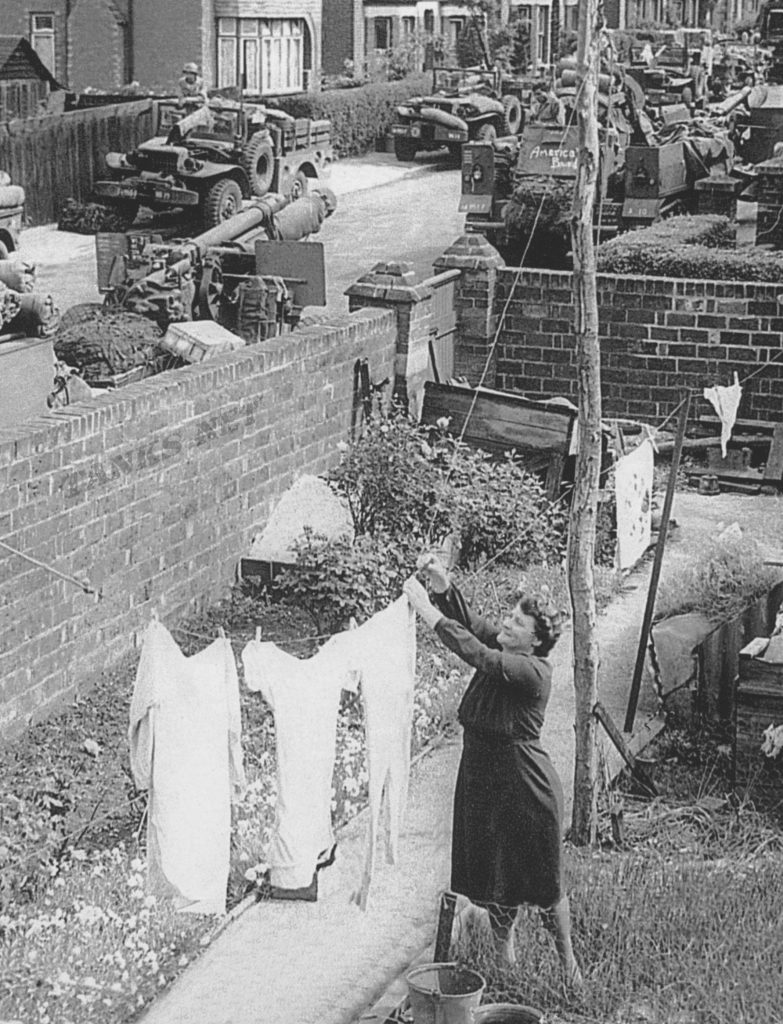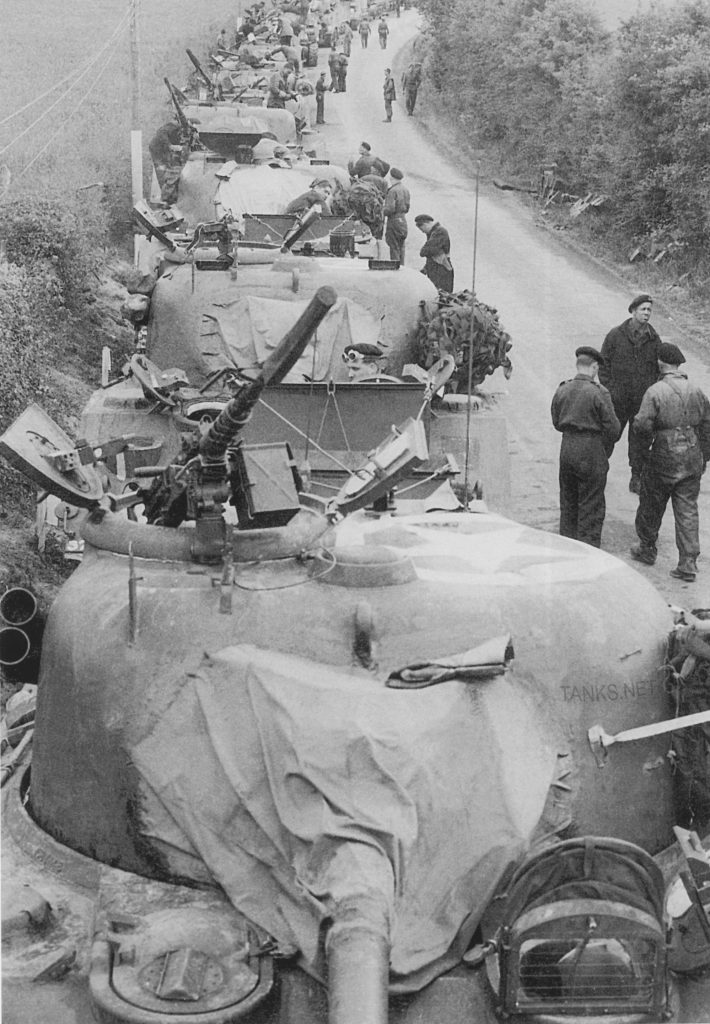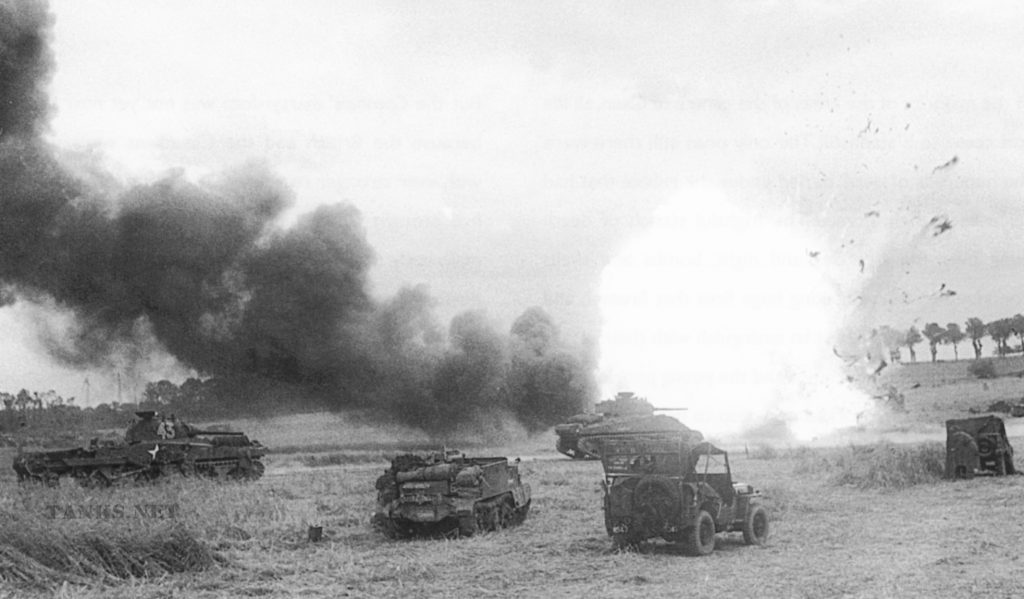Operation Overlord was the codename for the Allied amphibious invasion of Normandy in France, which began on June 6, 1944 – a date that is remembered as D-Day – and ended on August 25 of that year, when Paris was liberated.
Sometimes know as the Battle of Normandy, Operation Overlord was the largest amphibious invasion in history, involving almost 3 million men, 12,000 aircraft, 3,500 artillery pieces and more than 4,000 tanks and tracked vehicles.
Allied tanks included the American Sherman and the British Churchill, Cromwell, Stuart, Crusader and Valentine. The British had their own version of the Sherman, the Firefly, which used a 17 pounder gun.
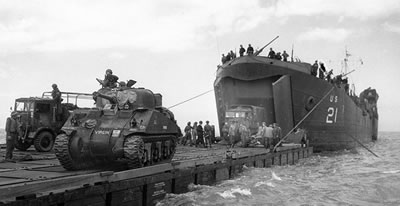
More airborne troops were used during the airborne assault on the beaches at Normandy than had ever been used before.
The majority of Allied troops involved in Operation Overlord were American and British. There were also Canadian, French and Polish forces.
Troops landed on five separate beachheads on the Normandy Coast. These had been codenamed Omaha, Utah, Gold, Sword and Juno. American troops landed on Omaha and Utah Beaches, British Troops on Gold and Sword Beaches and Canadian troops on Juno Beach.
Hobart’s Funnies
During the invasion, allied troops would have to land on an open beach, where they would face open fire, barbed wire, ditches, obstructions, antitank weapons and a possible counterattack involving Axis tanks.
British command knew that a specialist armored formation would be needed to overcome the many anti-tank defenses set up by the Germans.
Major-General Percy Hobart, an engineer who commanded Britain’s 79th Armoured Division, was given the task of creating these specialist armored vehicles, which came to be known as Hobart’s Funnies.
Hobart knew that he had to create an amphibious tank that would be able to come ashore and act as fire support.
Although the Japanese had developed amphibious tanks, these were lightly armed, and the Allies required an amphibious tank with more firepower.
Hobart used the Sherman as the basis for his amphibious tank – the Sherman Duplex Drive (Sherman DD).
The Sherman DD had a flotation screen and used screws to move it through the water.
A landing craft could launch it offshore, and it could then get to the beach on its own.
Once the Sherman DD was on the beach, it would drop its flotation screen and function as an ordinary Sherman tank.
The Crab was one of Hobart’s Funnies. The Crab acted as a mine clearer. It had chains that whirled around a rotating drum and beat the ground ahead of the tank. If a mine was set off, the chains would be thrown upward but would not be damaged. The Crab also functioned as a normal Sherman when it wasn’t clearing mines.
Another of Hobart’s Funnies was the Assault Vehicle Royal Engineers (AVRE). Based on the British Cromwell tank, the AVRE was used for battlefield demolition. In place of the Cromwell’s usual main gun, it had an 11.4 inch (290mm) petard – a short-barreled gun that fired a large explosive.
The AVRE could also be used as a mine clearer and a bridgelayer. It could lay a carpet of tubes across soft ground to create a causeway or drop fascines into a ditch. The AVRE could be used to deploy remotely detonated explosives.
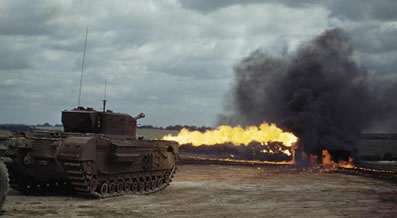 One of Hobart’s Funnies, the Crocodile acted as a flamethrower. It was a Churchill tank with a huge tank of gasoline towed behind it.
One of Hobart’s Funnies, the Crocodile acted as a flamethrower. It was a Churchill tank with a huge tank of gasoline towed behind it.
A very useful tank adaptation was the Canal Defence Light (CDL). This was a searchlight inside a turret with shutters, which was fitted onto an M3 tank. The CDL could flicker rapidly, which would disorient the enemy, destroying their night vision. Although the Canal Defence Light was not used on D-Day, it was used later during Operation Overlord.
Some historians claim that the greater losses suffered by American soldiers trying to get onto the beaches, as compared with their British counterparts, can be ascribed, at least partly, to the British forces’ use of Hobart’s Funnies.
Bocage Combat
By the end of June 6, the Allies had secured all five beachheads. It was then necessary for them to move inland into the Normandy countryside. This terrain, known as bocage, was characterized by high, thick hedgerows.
In this environment, tanks and infantry became separated from one another.
Axis soldiers would hide in the hedges and shoot Allied infantry with machine guns. The Allied infantry soldiers did not have tanks to protect them.
If a Sherman tank tried to ram through a hedge, it would become stuck in the hedge and the tank’s bow would get pushed up, making it the perfect target for a Panzerfaust anti-tank weapon.
The Allies developed ram bumpers and hedgerow cutters to enable tanks to get through the hedgerows safely. The most famous of these is probably the Culin hedgerow cutter, which was invented by American Sergeant Curtis Grubb Culin III. The Culin Hedgerow Cutter was made up of sharp steel spikes that were fitted to the front of a tank. The cutter would cut through a hedgerow, creating an opening for the tank and the troops that followed. The steel for the Culin Hedgerow Cutter came from metal obstacles that the Germans had left on the beaches.
Culin received the Legion of Merit award for his invention.
The Allies developed various tactics for using one tank, supported by a small infantry force, to fight off enemy infantry. With one method, a tank would fire at enemy troops through a hedge while it used the next hedge as cover. While the tank was firing, infantry would move through the hedge and attack the enemy position with grenades. Engineers would then blow up a hole in the hedge. This would allow the tank to pass through the hedge and join the infantry assault.
Another method was to use a tank to hose a section of hedgerow with machine gun fire. This would cover the infantry’s advance.
Some units would use their tanks to penetrate a hedgerow. The tanks would then turn along the hedgerow. Enemy units hiding in the hedgerow become trapped by tanks on both sides. Infantry would then close in on the enemy.
German tanks used in the bocage included the Panther (Panzer V) and the Tiger I (Panzer VI).
The Tiger I Heavy Tank was a particularly formidable threat. It was not very fast, it used up a great deal of fuel and it often broke down. However, in the bocage, these problems were not important. The Tiger I just had to sit in the woods and wait to ambush Allied troops. Even if the Tiger was spotted, its armor was so strong that it had a good chance of surviving enemy hits.
Nevertheless, there were many fewer Tigers than there were Shermans. Only about 1,350 Tiger I tanks were ever built. When Tigers broke down, it was hard to repair them, so they were often abandoned. The Allies had more than 40,000 Shermans. Losing a tank would not slow them down much.
Battle of Villers-Bocage
The British wanted control of the city of Caen, which was nine miles south of Sword Beach.
British General Bernard Montgomery had wanted Caen to be captured on D-Day. However, British forces advancing toward Caen were delayed by German defenses.
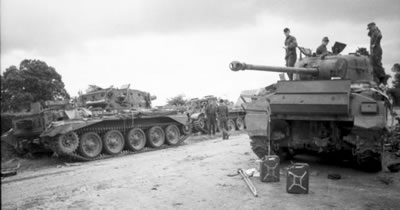 On the morning of June 13, 1944 on their approach to Caen, the 22nd Armoured Brigade of the 7th Armoured Division reached the town of Villers-Bocage, which was right in the way of a strategically important hill known as Point 213.
On the morning of June 13, 1944 on their approach to Caen, the 22nd Armoured Brigade of the 7th Armoured Division reached the town of Villers-Bocage, which was right in the way of a strategically important hill known as Point 213.
When the British soldiers reached the town, they were told to take a break.
Unbeknownst to them, they were being watched. Six Tiger tanks had been hidden inside the town.
Additional panzers were stretched out along the road to Paris. These had not been able to reach Villers-Bocage because of interference from Allied air strikes.
The German tank unit was under the command of Obersturmführer Michael Wittmann, a highly decorated tank commander in the Waffen-SS who had been responsible for more than 100 tank kills before arriving in Normandy.
As the British moved through the town, Wittmann sent 4 of his Tigers to Point 213.
The two other Tigers, one of which was commanded by Wittmann, drove toward the road junction in the town.
Soon, Wittmann’s tank broke down, and he was forced to take the other Tiger and move forward on his own.
When Wittmann’s attack started, many of the British tank crewmen hadn’t had the chance to get back inside their tanks.
The attack began with Wittmann being destroying almost everything in his path.
When more British tanks arrived in the town, Wittmann turned around and drove back the way he came.
Wittmann’s tank tracks were then disabled by a British 6-pounder anti-tank gun.
He and his crew then engaged enemy targets that were within range of the tank.
Eventually, both sides withdrew, with Wittmann and his crew abandoning their tank.
By the end of the day, however, more German tanks had arrived at Villers-Bocage – Tigers and Panzer IVs.
The Battle of Villers-Bocage ended with the loss of about 30 British tanks. These included Cromwells, Stuarts and Sherman Fireflies.
German losses were much less – Only 11 German tanks – 5 Panzer IVs and 6 Tigers – were put out of action. Three of the Tigers were eventually repaired and put back into service.
Wittmann has been credited with single-handedly knocking out 10 British main battle tanks, 3 light tanks, 13 armored half-tracks and 2 anti-tank guns during the battle.
Battle for Caen
On July 7, after a number of previous attempts to take Caen had failed, British General Bernard Montgomery ordered a massive airstrike against the city of Caen. The pilots halted a few seconds before releasing the bombs, because they were afraid of friendly fire. Because of this, the German defenses did not receive much damage but there was a great deal of damage to the city.
British and Canadian troops then advanced on the ground, but they were slowed by German defenses, which included a large tank counterattack.
The British held on to Caen, forcing the Germans to commit more troops to the area. This gave American General George S. Patton’s Third Army the opportunity to move through northwestern France.
Liberation of Paris
In August 1944, Americans broke through German lines west of St. Lo.
British typhoon bombers and American tanks broke up an armored German counterattack.
The Germans retreated west and were trapped in the Falaise pocket, an area around the town of Falaise. British and Canadian troops were to the north and Americans were coming from the south.
Between August 16 and 19, remnants of Germany’s Seventh Army and Fifth Panzer army managed to break through and eventually get to the Seine. The Germans then built ferries and pontoons to carry themselves across the river while fighting off Allied advances. At that time, the Allies had control of the west bank of the Seine.
On August 19, 1944, French resistance forces rose up against the German garrison in Paris. The Free French 2nd Armored Division arrived to liberate the city on August 24.
The German commander in Paris surrendered the following day.
